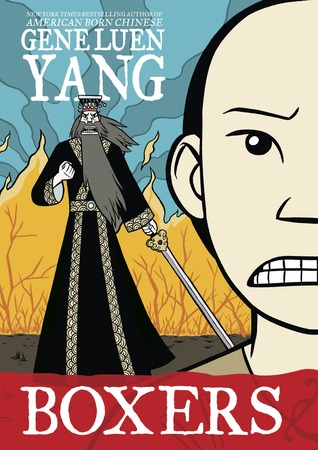Why not take a page of text and do an erasure poem with it? Or, as Austin Kleon calls them, a newspaper blackout poem?
How about a ThingLink?
And maybe you could take a complicated historical event, like the Boxer Rebellion in China, and make it a two-part graphic novel that explores both sides of the story.
Boxers & Saints Boxed Set
by Gene Luen Yang, First Second, September, 2013
review copies from the public library
I think it's fair to say that I would never have picked up a history of the Boxer Rebellion to read in my spare time if it hadn't been in graphic novel format. And I think it's fair to say that a historical description of the rebellion/movement would never have given me such a deeply personal glimpse into both sides of the story.
An added bonus was finding this review on GoodReads by FirstSecond, and gaining an even deeper appreciation for the complexity of what Gene Yang created in these two books:
One of the things that makes both Boxers and Saints fascinating is how the author treats religion.
Boxers features a magical realistic element; the Chinese gods (who the characters know mainly through the opera) possess the Boxer rebels and help power their rebellion; when the rebels go to war, they feel that they are taken over by the gods and protected and driven by them. In the book, Gene draws the gods as they are taking over the Boxers and propelling them into battle. The pictures aren't just people saying, 'a god is possessing me!' while nothing is happening -- a god is _there_.
This is clearly meant (through our 21st-century lens) to be magical realism; these gods aren't something that we today are meant to be like, 'drat those gods possessing people and causing rebellions all the time; you'd think they would know better after all these years of being gods and all.'
This is all thrown into question in a fascinating way in Saints, when Gene (a devout Catholic) draws the main character seeing an actual Catholic saint -- Joan of Arc -- and at one point, seeing Jesus. In the same way that the Chinese gods appear on the pages of Boxers, the Catholic saint and deity appear throughout the pages of Saints. Does their more-convincing reality (both in our culture today and in the author's life) throw into question the reality of the Chinese gods? Does this set-down-on-paper reflection of the beliefs of that time, both equally devout -- call into question the veracity of our own beliefs today, and the amount our contemporary culture is influencing what our beliefs are?The format of the graphic novel has huge possibilities both as a launch-pad for introducing readers to new information (history, science, etc), and as a way for readers to process their learning of informational text.



I loved Boxers and Saints. Such a great way to see history.
ReplyDelete